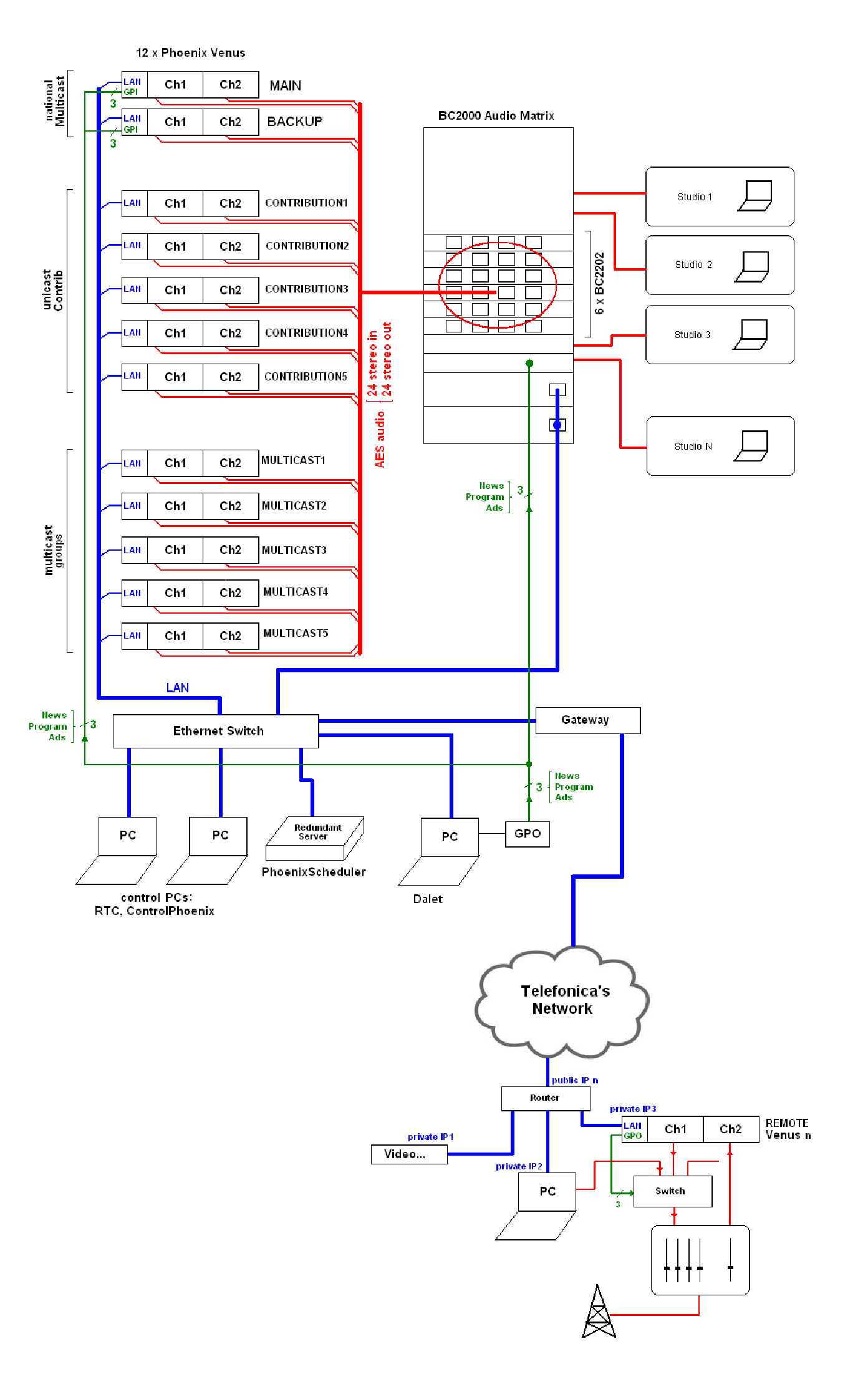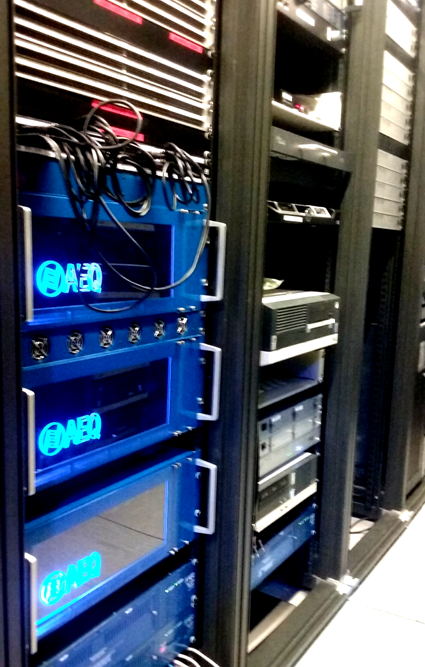DEVELOPMENT OF A BIDIRECTIONAL AoIP TRANSPORT SYSTEM FOR RADIO COMPANIES 23/02/2017

The system substitutes a satellite-based unidirectional broadcast system and provides full-duplex audio to more than 125 stations in a flexible way and allowing national, static-regional or occasional local multicast groups.
By Xavier Cabestany, Head of Technical Infrastructures at La Xarxa Audiovisual Local
1. Introduction
La Xarxa Audiovisual Local (XAL) is a public audiovisual production entity, created by the Deputation of Barcelona. It generates contents of local nature. XAL counts with its Central Office in Barcelona and more than 125 associated radio stations. XAL provides its contents to these stations to combine them with local productions. The stations contribute with signals to the main station to create programs together.
La Xarxa has been distributing the common signal by means of a satellite-based link. In 2015, it was decided to migrate to an IP network, which XAL has contracted to Telefónica. AEQ has provided audiocodecs and control software.
Nearly 150 Phoenix Venus audiocodecs have been supplied, and software has been developed for:
- Control and monitoring of all audiocodecs from any PC connected to the Internet.
- Program connection and disconnection events
- Integration of the control with an existing audio matrix.
- Create and activate local or regional broadcast groups.
- Manage point-to-point contribution connections from the central location.
2. Project requirements and implementation
Broadcasting of the Main program:
Satellite links are replaced by terrestrial IP connections using Phoenix Venus IP audiocodecs, through multicast groups to which all local stations are subscribed. The audiocodecs "MAIN" and "BACKUP" send the audio to multicast IPs that in turn broadcast the audio to the remote devices subscribing to the multicast.
There is a Phoenix VENUS audiocodec at each local station. Channel 1 receives the multicast audio, with OPUS encoding, obtaining a stereo channel 20Hz-20KHz with very low latency.
The existing broadcast automation system generates GPOs for the multicast VENUS (MAIN and BACKUP) GPI which sends to the selected audiocodec, transporting orders to switch the remote audio source or console control.
The control server continuously monitors the status of MAIN and BACKUP codecs and if the active fails, it resets the connection to the other. The audio input is distributed to both units from the matrix.
Regional and Local Multicast Groups
There are multicast groups of reduced size and limited duration. Another 5 dual-channel VENUS Audiocodecs are programmed for this purpose.
There are also groups with fewer receivers or subscribers, where the “main station” is a local station sharing its program feed.
In both cases, these groups are controlled with a scheduling software that creates groups, defines the time slots, and automatically controls the connections of any of the involved audiocodecs: If an audiocodec is switched from the main group to a regional or local group, once finished its connection, it is automatically deactivated and returns to its previous state and continues receiving the main program.
Remote contributions
Channel 2 of the local VENUS makes contribution towards the main station. For this, in the main station there are 5 VENUS for "CONTRIBUTION" each with 2 channels. This allows for up to 10 simultaneous contributions from different associated stations. These 10 bidirectional stereo channels are connected to the matrix. They connect to the studios so as to contribute to program or provide coordination channels. Calls are manually placed from central control in the main station using a phone book and SmartRTP to establish the communication.
3.- Hardware architecture
See figure 1 (only one remote station is represented):
- A set of 12 VENUS audiocodecs are installed at the main station. Each provides two stereo bidirectional channels:
- MAIN and BACKUP both transmit the main program.
- MULTICAST1..5 allow for the broadcasting of alternative programs to groups of remote locations.
- CONTRIBUTION1..5 allow for the reception of point-to-point connections from any remote end to elaborate programs from Barcelona. The return channels (unicast) are used as N-1 feedbacks or for coordination from each contributing local station.
- All codecs in the System (both in central station and remote locations) are on the same IP logical network - wiring shown in blue. The codec control service reaches all of them and the AEQ BC2000D audio switching matrix, to execute salvos.
- All audio connections in the central office (represented in red) are digital AES/EBU
- The ControlPhoenix application is installed on management PCs. On the server, and in addition to this, the control service is installed. In the studio workstations, an application for control of contributions has been installed - XAL Control,
- The automation system GPOs (Disconnections, Bulletins and Programs), represented in green, are connected to the BC2000D matrix, and multicast audiocodecs (MAIN and BACKUP).

4. Project development
The system has been a coordinated development between Xarxa, Telefónica, and AEQ. The applications were specifically developed for the purpose and customizations of already existing ones, debugged in an operational model built at AEQ and then migrated to the server of the Xarxa.
Telefónica deployed and configured the network infrastructure. They provided AEQ a Remote User Access to connect from AEQ’s offices in Madrid for installation, configuration, verifications, etc.
Once the definitive server was installed in Barcelona, all the VENUS AudioCodecs are being distributed and deployed and taken into service on their remote locations.
5. Conclusions
In February 2017, more than 85 stations are already connected. The savings with regards to operating costs compared to the previous satellite infrastructure is considerable and, in addition the network is benefitting from greater flexibility, very low latency and fully bidirectional links.
It has been necessary to deal with challenges concerning the traffic distribution (IP multicast), QoS and bandwidth management, centralized control of all equipment and management tools, adaptation of the software to specific needs, documentation and configuration, training etc.
Using the OPUS algorithm, Phoenix VENUS audiocodecs provide a clean audio signal with practically transparent quality and no data/audio loss. The software is being used on a daily basis and, together with the integration with the BC 2000D matrix, allows us great flexibility to produce and broadcast programs with the associated stations.

Central Control at Barcelona
Matrix and codecs








